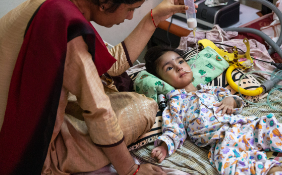Trojan horse bacteria sneak cancer-killing viruses into tumors
The new platform combines the bacteria's tendency to find and attack tumors with the virus's natural preference for infecting and killing cancerous cells. Tal Danino, an associate professor of biomedical engineering at Columbia Engineering, led the team's effort to create the system, which is called CAPPSID (short for Coordinated Activity of Prokaryote and Picornavirus for Safe Intracellular Delivery). Charles M. Rice, an expert in virology at The Rockefeller University, collaborated with the Columbia team.
"We aimed to enhance bacterial cancer therapy by enabling the bacteria to deliver and activate a therapeutic virus directly inside tumor cells, while engineering safeguards to limit viral spread outside the tumor," says co-lead author Jonathan Pabón, an MD/PhD candidate at Columbia.
The researchers believe that this technology -- validated in mice -- represents the first example of directly engineered cooperation between bacteria and cancer-targeting viruses.
The approach combines the bacteria's instinct for homing in on tumors with a virus's knack for infecting and killing cancer cells. "By bridging bacterial engineering with synthetic virology, our goal is to open a path toward multi-organism therapies that can accomplish far more than any single microbe could achieve alone," says Zakary S. Singer, a co-lead author and former postdoctoral researcher in Tal Danino's lab.
"This is probably our most technically advanced and novel platform to date," says Danino, who is also affiliated with the Herbert Irving Comprehensive Cancer Center at Columbia University Irving Medical Center and Columbia's Data Science Institute.
Sneaking past the immune system
One of the biggest hurdles in oncolytic virus therapy is the body's own defense system. If a patient has antibodies against the virus -- from a prior infection or vaccination -- those antibodies can neutralize it before it reaches a tumor. The Columbia team sidestepped that problem by tucking the virus inside tumor-seeking bacteria.
"The bacteria act as an invisibility cloak, hiding the virus from circulating antibodies, and ferrying the virus to where it is needed," Singer says.
Pabón says this strategy is especially important for viruses that people are already exposed to in daily life.
#Bacteria
#Microbiology
#GoodBacteria
#BadBacteria
#GutHealth
#Microbiome
#AntibioticResistance
#BacterialInfection
#Probiotics
#BacterialCulture
World Cell Biologist Awards:
Website Link : cellbiologist.org
Nomination Link : cellbiologist.org/award-nomination/?ecategory=Awards&rcategory=Awardee Contact Us: support@cellbiologist.org
Follow Us On :
Twitter : twitter.com/account/access
Linkedin : .linkedin.com/in/research-scholar-10278a323/
Tumblr ; tumblr.ccom/




Comments
Post a Comment